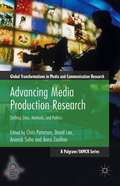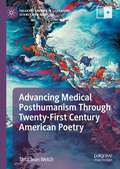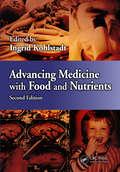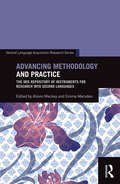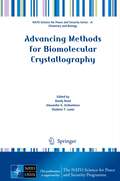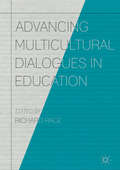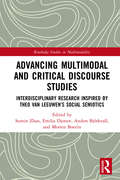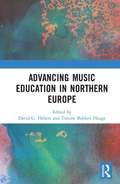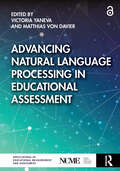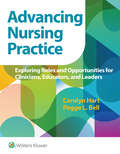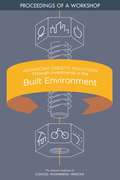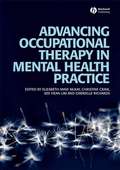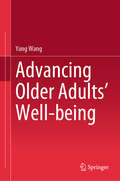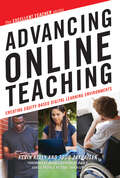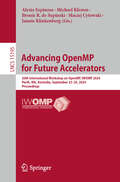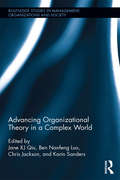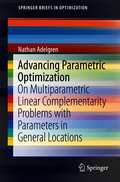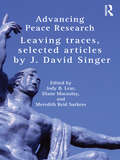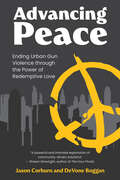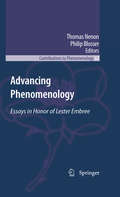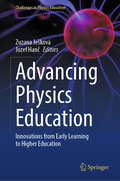- Table View
- List View
Advancing Maternal Health Equity and Reducing Maternal Morbidity and Mortality: Proceedings of a Workshop
by Board on Population Health and Public Health Practice National Academies of Sciences, Engineering, and Medicine Health and Medicine DivisionThe United States faces an alarmingly high rate of maternal morbidity and mortality, distinguishing it from other high-income countries that have achieved decreases in these rates in recent years. U.S. maternal morbidity and mortality rates are disproportionate across racial, ethnic, socioeconomic, and geographic groups. Statistics on maternal health outcomes reveal that there are challenges to protecting both the lives and future health of birthing people and their children. Recognizing the urgency of this growing problem, the National Academies Board on Population Health and Public Health Practice convened a 2-day virtual workshop, Advancing Maternal Health Equity and Reducing Maternal Mortality. The workshop examined the current state of maternal health in the United States and explored the factors needed to help communities and health care systems become more effective in reducing maternal morbidity and mortality and improving health outcomes through the fourth trimester. This publication summarizes the presentations and discussions of the workshop.
Advancing Media Production Research: Shifting Sites, Methods, And Politics (Global Transformations In Media And Communication Research - A Palgrave And Iamcr Ser.)
by David Lee Chris Paterson Anamik Saha Anna ZoellnerThis anthology explores challenges to understanding the nature of cultural production, exploring innovative new research approaches and improvements to old approaches, such as newsroom ethnography, which will enable clearer, fuller understanding of the workings of journalism and other forms of media and cultural production.
Advancing Medical Posthumanism Through Twenty-First Century American Poetry (Palgrave Studies in Literature, Science and Medicine)
by Tana Jean WelchAdvancing Medical Posthumanism Through Twenty-First Century American Poetry places contemporary poetics in dialogue with posthumanism and biomedicine in order to create a framework for advancing a posthuman-affirmative ethics within the culture of medical practice. This book makes a case for a posthumanist understanding of the body—one that sees health and illness not as properties possessed by individual bodies, but as processes that connect bodies to their social and natural environment, shaping their capacity to act, think, and feel. Tana Jean Welch demonstrates how contemporary American poetry is specifically poised to develop a pathway toward a posthuman intervention in biomedicine, the field of medical humanities, medical discourse, and the value systems that guide U.S. healthcare in general.
Advancing Medicine with Food and Nutrients
by Ingrid KohlstadtFood and nutrients are the original medicine and the shoulders on which modern medicine stands. But in recent decades, food and medicine have taken divergent paths and the natural healing properties of food have been diminished in the wake of modern technical progress. With contributions from highly regarded experts who work on the frontlines of disease management, the bestselling first edition of Advancing Medicine with Food and Nutrients, Food and Nutrients in Disease Management effectively brought food back into the clinical arena, helping physicians put food and nutrients back on the prescription pad.Board-certified in General Preventive Medicine, Ingrid Kohlstadt, MD, MPH has been elected a Fellow of the American College of Nutrition and a Fellow of the American College of Preventive Medicine. Guided by Dr. Kohlstadt, this authoritative reference equips clinicians with the information they need to fully utilize nutritional medicine in their practice. New in the Second Edition Toxic exposures such as molds, microbial infections, xenoestrogens, heavy metals, and inert nanoparticles Food safety issues: precautions for patients with preexisting medical conditions, adequate labeling of food allergens such as gluten, potential adverse effects of artificial sweeteners, consequences of applying ionizing radiation to food, food-borne mycotoxins, critical food restrictions following bariatric surgery, precautions for preparing food in the home Consumer advocacy issues on navigating claims of medical foods and dietary supplements Physical forces on nutritional needs, such as ultraviolet light initiating vitamin D synthesis, non-ionizing radiation’s effects on brain glucose metabolism and excess body fat’s effects on inflammation and hydration Preventive medicine and how to preserve resiliency at the individual and public health levels Written by doctors for doctors, Advancing Medicine with Food and Nutrients, Second Edition reunites food and medicine. Buttressed with new evidence, leading physicians on the frontlines of disease management apply the latest scientific advances to the clinical practice of medicine. Each chapter offers adjuncts to standard care, fewer side effects, improved risk reduction, or added quality of life.An article by Ingrid Kohlstadt on education and nutrition appeared in TIME Magazine online on November 12, 2014.
Advancing Methodology and Practice: The IRIS Repository of Instruments for Research into Second Languages (Second Language Acquisition Research Series)
by Alison Mackey Emma MarsdenInstruments for Research into Second Languages is an accessible introduction to understanding and evaluating existing and emerging methodologies in L2 research. The book provides an introduction to the data collection materials available in the IRIS database. IRIS is an open access, searchable repository of instruments used to elicit data for research into second and foreign language learning and teaching. The book is aimed at graduate students, researchers and educators in the fields of Applied Linguistics and Second Language Acquisition. Featuring contributions from top scholars in the field, this dynamic volume includes empirical research carried out using innovative instruments held in IRIS, offering insights into their basic mechanics, how and why they are used, as well as the challenges they can present. The chapters describe the kinds of data (evidence about knowledge, processing, interaction, learning, and motivation) that result from these methods, and they discuss conditions that lead to reliable and valid data collection and analysis. This unique collection provides researchers, professionals, and students with up-to-date responses to practical and theoretical questions about how second language learning and teaching can be investigated using the IRIS database of instruments. IRIS was funded by the Economic and Social Research Council and is a long term British Academy Research Project.
Advancing Methods for Biomolecular Crystallography (NATO Science for Peace and Security Series A: Chemistry and Biology)
by Alexandre G. Urzhumtsev Randy Read Vladimir Y. LuninThis work presents a snapshot of the state of the art of modern biomolecular crystallography, from crystallisation through structure determination and even interactive presentation on the web. Methods driving the latest automated structure determination pipelines are explained, as well as how to deal with problems such as crystal pathologies that still demand expert analysis. These methods are illustrated through their application to problems of great biological interest, such as the molecular machinery underlying the complement pathway, the mechanism of action of monoamine oxidase inhibitors, and the structure of the eukaryotic ribosome. Complementary approaches, such as neutron diffraction, small angle X-ray scattering, coherent diffraction and computational modelling, are also explored.
Advancing Multicultural Dialogues in Education
by Richard RaceThis edited collection advances the call for continued multicultural dialogues within education. Dialogue and education are the two most essential tools that can help tackle some of the biggest problems we are facing across the globe, including fanaticism, chauvinistic nationalism, religious fundamentalism and racism. The contributors to this book explore the necessity of sustained dialogue within the wider social and political sciences alongside in national and international politics, where more multicultural voices need to be heard in order to make progress. The book builds on existing evidence and literature to advocate in favour of this movement, and highlights how important and significant multiculturalism and multicultural education remains. It will be essential reading for students and academics working in the fields of education and sociology, particularly those with an interest in social justice and multiculturalism.
Advancing Multimodal and Critical Discourse Studies: Interdisciplinary Research Inspired by Theo Van Leeuwen’s Social Semiotics (Routledge Studies in Multimodality)
by Sumin Zhao Emilia Djonov Anders Björkvall Morten BoeriisAs a founder and leading figure in multimodality and social semiotics, Theo van Leuween has made significant contributions to a variety of research fields, including discourse analysis, sociolinguistics, communication and media studies, education, and design. In celebration of his illustrious research career, this volume brings together a group of leading and emerging scholars in these fields to review, explore and advance two central research agendas set out by van Leeuwen: the categorisation of the meaning potential of various semiotic resources and the examination of their uses in different forms of communication, and the critical analysis of the interaction between semiotic forms, norms and technology in discursive practices. Through 11 cutting-edge research papers and an experimental visual essay, the book investigates a broad range of semiotic resources including touch, sound, image, texture, and discursive practices such as community currency, fitness regime, film scoring, and commodity upcycling. The book showcases how social semiotics and multimodality can provide insights into the burning issues of the day, such as global neoliberalism, terrorism, consumerism, and immigration.
Advancing Music Education in Northern Europe
by David G. Hebert Torunn Bakken HaugeAdvancing Music Education in Northern Europe tells the story of a unique organization that has contributed in profound ways to the professional development of music teachers in the Nordic and Baltic nations. At the same time, the book offers reflections on how music education and approaches to the training of music teachers have changed across recent decades, a period of significant innovations. In a time where international partnerships appear to be threatened by a recent resurgence in protectionism and nationalism, this book also more generally demonstrates the value of formalized international cooperation in the sphere of higher education. The setting for the discussion, Northern Europe, is a region arguably of great importance to music education for a number of reasons, seen, for instance, in Norway’s ranking as the “happiest nation on earth”, the well-known success of Finland’s schools in international-comparative measures of student achievement, how Sweden has grappled with its recent experience as “Europe’s top recipient of asylum seekers per capita”, and Estonia’s national identity as a country born from a “Singing Revolution”, to name but a few examples. The contributors chronicle how the Nordic Network for Music Education (NNME) was founded and developed, document its impact, and demonstrate how the eight nations involved in this network – Norway, Iceland, Denmark, Sweden, Finland, Estonia, Latvia, and Lithuania – are making unique contributions of global significance to the field of music education.
Advancing Natural Language Processing in Educational Assessment
by Matthias Von Davier Victoria YanevaAdvancing Natural Language Processing in Educational Assessment examines the use of natural language technology in educational testing, measurement, and assessment. Recent developments in natural language processing (NLP) have enabled large-scale educational applications, though scholars and professionals may lack a shared understanding of the strengths and limitations of NLP in assessment as well as the challenges that testing organizations face in implementation. This first-of-its-kind book provides evidence-based practices for the use of NLP-based approaches to automated text and speech scoring, language proficiency assessment, technology-assisted item generation, gamification, learner feedback, and beyond. Spanning historical context, validity and fairness issues, emerging technologies, and implications for feedback and personalization, these chapters represent the most robust treatment yet about NLP for education measurement researchers, psychometricians, testing professionals, and policymakers.
Advancing Nuclear Medicine Through Innovation
by National Research Council Institute of Medicine of the National AcademiesNearly 20 million nuclear medicine procedures are carried out each year in the United States alone to diagnose and treat cancers cardiovascular disease and certain neurological disorders. Many of the advancements in nuclear medicine have been the result of research investments made during the past 50 years where these procedures are now a routine part of clinical care. Although nuclear medicine plays an important role in biomedical research and disease management its promise is only beginning to be realized. Advancing Nuclear Medicine Through Innovation highlights the exciting emerging opportunities in nuclear medicine which include assessing the efficacy of new drugs in development individualizing treatment to the patient and understanding the biology of human diseases. Health care and pharmaceutical professionals will be most interested in this book's examination of the challenges the field faces and its recommendations for ways to reduce these impediments.
Advancing Nursing Practice: Exploring Roles and Opportunities for Clinicians, Educators, and Leaders
by Carolyn Hart Pegge BellAdvancing Nursing Practice: Exploring Roles and Opportunities for Clinicians, Educators, and Leaders helps your students understand how to apply classroom knowledge to eventual professional practice as a CRNA, CNM, CNS, or NP/DNP, or in a faculty or administrative position. With the book’s succinct, conversational style, you can easily focus their attention on the core competencies, practices, leadership styles, and other essential topics. This brand-new volume features interviews with advanced practice nurses in active practice in the book as well as videos available online.
Advancing Nutrition and Food Science: 80th Anniversary Of The Food And Nutrition Board: Proceedings Of A Symposium
by Food and Nutrition Board National Academies of Sciences, Engineering, and Medicine Health and Medicine DivisionThe Food and Nutrition Board (FNB) of the National Academies of Sciences, Engineering, and Medicine was convened in 1940 in response to a request from the U.S. National Defense Advisory Commission to the National Academy of Sciences for aid in studying problems of nutrition in the United States. Today the FNB is the focal point for activities concerned with food, nutrition, and food safety, and their roles in health maintenance and disease prevention. Now in its 80th year, the FNB has continued its growth and expanded its reach both domestically and internationally, providing visionary leadership across a range of nutrition and food science issues toward the improvement of human health. In honor of its 80 years of service to the nation, the FNB convened a public symposium to review the origin and history, policy influence, and future directions of the FNB. This publication summarizes the presentations of the event.
Advancing Obesity Solutions Through Investments in the Built Environment: Proceedings Of A Workshop
by Engineering Medicine National Academies of SciencesThe built environment—the physical world made up of the homes, buildings, streets, and infrastructure within which people live, work, and play—underwent changes during the 20th and 21st centuries that contributed to a sharp decline in physical activity and affected access to healthy foods. Those developments contributed in turn to the weight gain observed among Americans in recent decades. Many believe, therefore, that policies and practices that affect the built environment could affect obesity rates in the United States and improve the health of Americans. The National Academies of Sciences, Engineering, and Medicine convened a workshop in September 2017 to improve understanding of the roles played by the built environment in the prevention and treatment of obesity and to identify promising strategies in multiple sectors that can be scaled up to create more healthful and equitable environments. This publication summarizes the presentations and discussions from the workshop.
Advancing Occupational Therapy in Mental Health Practice
by Kee Hean Lim Gabrielle Richards Christine Craik Elizabeth McKayAdvancing Occupational Therapy in Mental Health Practice looks at the contribution that occupational therapists make to the lives of clients living with mental illness. It examines current practice developments and the innovative research that is shaping occupational therapy within the mental health arena, nationally and internationally. The book employs a distinctive and engaging narrative approach, bringing to life key issues in practice and research. It introduces the reader to the mental health context, opening with a historical overview and then exploration of the current developments in occupational therapy before moving on to discuss the cultural context and the need for cultural sensitivity in practice. Service users and expert clinicians offer their narratives, through which the clinical utility and cultural appropriateness of existing occupational therapy concepts, assessments and outcome measures are discussed and the associated implications for practice highlighted. Advancing Occupational Therapy in Mental Health Practice introduces and explores a variety of specialised work contexts from practicing in acute inpatient settings to crisis intervention, home treatment, forensic mental health settings and the specialist role of occupational therapy in community mental health and social services. Chapters are enriched with case stories, personal narratives and guided reflection.
Advancing Older Adults' Well-being
by Yang WangThis book introduces part of the advances of the aging research conducted by Dr. Yang Wang and his collaborators since 2022. It covers several topics related to older adults, including their psychological and social well-being, their role as caregivers and care receivers, the impact of the maltreatment experience in early life, and how witnessing elder abuse could influence children. This book is composed of nine research articles and manuscripts. Most of the studies were conducted in China or USA, using nationally representative sample. This book is a valuable resource for readers who care about older adults’ well-being and the advancement of it.
Advancing Online Teaching: Creating Equity-Based Digital Learning Environments
by Kevin Kelly Todd D. ZakrajsekThe goal of teaching online is fundamentally the same as teaching face-to-face: facilitating the learning of all students to the greatest extent possible. This book differs from other books on online teaching in that, in the process of offering guidance on course design and planning, developing outcomes and appropriate engaging activities, managing the workload and assessment, the authors pay explicit attention throughout to the distinct and diverse needs of students and offer effective strategies to accommodate them in a comprehensive and inclusive way by using the principles of Universal Design for Learning. By following those principles from the outset when planning a course, all students will benefit, and most particularly those whom the research shows have the greatest achievement gaps when taking online courses -- males, first generation and low income students, those from underrepresented minority groups, the academically underprepared, students with disabilities, and those with limited online access or lacking readiness for online learning. Beyond good planning and design, Kelly and Zakrajsek offer ideas for creating inclusive course environments and activities, such as using culturally appropriate content and making it accessible in multiple formats. They also share methods to foster faculty-learner interaction and increase personal connections with students, and among students, through group activities or learning communities, which are so critical to motivation and success. Faculty new to online teaching as well as more experienced readers will find a wealth of practical guidance on developing and honing both fully online and blended courses and, as importantly, a wealth of proven ideas to help the new generation of students with diverse needs to succeed.
Advancing OpenMP for Future Accelerators: 20th International Workshop on OpenMP, IWOMP 2024, Perth, WA, Australia, September 23–25, 2024, Proceedings (Lecture Notes in Computer Science #15195)
by Bronis R. de Supinski Michael Klemm Jannis Klinkenberg Alexis Espinosa Maciej CytowskiThis book constitutes the refereed proceedings of the 20th International Workshop on OpenMP: Advancing OpenMP for Future Accelerators, IWOMP 2024, in Perth, WA, Australia, during September 23–25, 2024. The 14 full papers presented in this book were carefully reviewed and selected from 16 submissions. They are grouped into the following topics: current and future openMP optimization; targeting more devices; best practices; tools; and simplifying parallelization.
Advancing Oral Health in America
by Committee on an Oral Health InitiativeThough it is highly preventable, tooth decay is a common chronic disease both in the United States and worldwide. Evidence shows that decay and other oral diseases may be associated with adverse pregnancy outcomes, respiratory disease, cardiovascular disease, and diabetes. However, individuals and many health care professionals remain unaware of the risk factors and preventive approaches for many oral diseases. They do not fully appreciate how oral health affects overall health and well-being. In Advancing Oral Health in America, the Institute of Medicine (IOM) highlights the vital role that the Department of Health and Human Services (HHS) can play in improving oral health and oral health care in the United States. The IOM recommends that HHS design an oral health initiative which has clearly articulated goals, is coordinated effectively, adequately funded and has high-level accountability. In addition, the IOM stresses three key areas needed for successfully maintaining oral health as a priority issue: strong leadership, sustained interest, and the involvement of multiple stakeholders from both the public and private sectors. Advancing Oral Health in America provides practical recommendations that the Department of Health and Human Services can use to improve oral health care in America. The report will serve as a vital resource for federal health agencies, health care professionals, policy makers, researchers, and public and private health organizations.
Advancing Organizational Theory in a Complex World: Advancing Research in a Complex World (Routledge Studies in Management, Organizations and Society)
by Chris Jackson Jane Qiu Ben Nanfeng Luo Karin SandersWhile research in organisational studies has become increasingly rich and complex, organisation researchers are constantly challenged by the growing quest for theoretical advancement and innovation. To conduct theoretically rigorous and innovative research, contemporary researchers and students must develop in-depth understanding of the theoretical traditions and future prospects of their discipline. This book provides a collection of cutting-edge research topics in the field of organisation and management and offers advanced research findings that explore the frontiers of the field. Advancing Organisational Theory in a Complex World aims to provide deep insights into many influential organisational theories, including, contingency theory, institutional theory, stewardship theory, population ecology theory, ambidexterity, and complexity theory. All these theories have been developed to explain the external and internal factors that influence organisational survival and evolvement. We focus on these theories because they represent some of the most important ways into the modern literature, counter-points to the modern literature, and a breath of fresh air to some theories which should be better known. This book shows the fruitfulness and the continuous vitality of the theoretical field of organisational studies in a critical and innovative way. Finally, this book is dedicated to Professor Lex Donaldson who is a thought leader in the field. The field owed this to Lex, for his lifelong dedication to organisational studies and for his creation and advancement of theories that have inspired several generations of researchers.
Advancing Parametric Optimization: On Multiparametric Linear Complementarity Problems with Parameters in General Locations (SpringerBriefs in Optimization)
by Nathan AdelgrenThe theory presented in this work merges many concepts from mathematical optimization and real algebraic geometry. When unknown or uncertain data in an optimization problem is replaced with parameters, one obtains a multi-parametric optimization problem whose optimal solution comes in the form of a function of the parameters.The theory and methodology presented in this work allows one to solve both Linear Programs and convex Quadratic Programs containing parameters in any location within the problem data as well as multi-objective optimization problems with any number of convex quadratic or linear objectives and linear constraints. Applications of these classes of problems are extremely widespread, ranging from business and economics to chemical and environmental engineering. Prior to this work, no solution procedure existed for these general classes of problems except for the recently proposed algorithms
Advancing Peace Research: Leaving Traces, Selected Articles by J. David Singer
by J. David SingerProfessor J. David Singer has been arguably the most important influence on quantitative research into the causes and attributes of war. His pioneering work on the Correlates of War project at the University of Michigan and his numerous books and articles have inspired generations of researchers in the fields of international relations, conflict analysis, security studies and peace science. This collection is a carefully selected overview of his work which provides not only an excellent introduction to his considerable methodological, theoretical and empirical contributions but also an intellectual history of developments in the field of international relations which are reflected in Professor Singer's work. This is essential reading for all those with an interest in the use of quantitative methods in social science, the changing nature of the study of international relations and the analysis of war and peace.
Advancing Peace: Ending Urban Gun Violence Through the Power of Redemptive Love (Urban and Industrial Environments)
by Jason Corburn DeVone BogganMission possible: ending gun violence in America&’s Black and brown communities.As COVID-19 took hold, urban gun violence exploded—but not in four cities in California. What did these cities have in common? The Advance Peace gun violence prevention program. In Advancing Peace, urban public health scholar Jason Corburn and the program&’s founder DeVone Boggan reveal how the community-based approach truly works, and how it holds out genuine hope, and proven solutions, for those trying to end the plague of gun violence in American cities.With powerful evidence and heartfelt stories from the front lines, the authors describe a transformation based on compassion and redemption. Without overlooking the legacy of slavery, racism, and poverty in America&’s urban areas, the book lays out evidence-based, practical, cost-effective steps that tap the forces of unconditional love, forgiveness, and unyielding focus to restore a sense of purpose to those at the center of the crisis and to heal their communities.
Advancing Phenomenology: Essays in Honor of Lester Embree (Contributions To Phenomenology #62)
by Thomas Nenon Philip BlosserThe title Advancing Phenomenology is purposely ambiguous. On the one hand, these essays document the progress that phenomenology as an ongoing and vibrant movement has made in the period of about a century since its inception. They illustrate the advance of phenomenology both in terms of the range of topics represented in this volume and in terms of the disciplinary and geographical diversity of the scholars who have contributed to it. The topics range from scholarly appropriations of past achievements in phenomenology, to concrete phenomenological investigations into ethics and environmental philosophy, as well as phenomenological reflections on the foundations of disciplines outside philosophy such as psychology, history, the social sciences, and archeology.
Advancing Physics Education: Innovations from Early Learning to Higher Education (Challenges in Physics Education)
by Zuzana Ješková Jozef HančThis book offers a rich selection of papers from a conference dedicated to the advancement of physics education at all levels. Addressing the pressing need for innovation in teaching and learning, the contributions span pre-school to higher education, showcasing a broad spectrum of innovative proposals aimed at enriching the physics learning experience. The contributions reflect key thematic tracks, including innovative strategies and pathways to improve physics education, lab work and experiments in physics education, digital technologies in physics education, and school-university collaborations. These tracks provide a cohesive structure, while the individual contributions present research-informed insights and exemplary teaching practices that resonate across age groups and educational contexts. For pre-school and primary learners, the papers highlight creative learning pathways, hands-on activities, and play-based strategies that introduce young minds to fundamental physical concepts in an engaging and accessible way. At the secondary level, the focus shifts to inquiry-based teaching practices, lab work, and the integration of digital tools that develop students&’ critical thinking skills and deepen their understanding of core physics principles. For higher education, the papers present advanced experimental techniques and interdisciplinary approaches, demonstrating effective strategies for teaching complex concepts to university students as well as novel methods for fostering connections between schools and universities, emphasizing how collaboration enhances teaching practices and supports student learning. Additionally, the contributions examine how physics education research informs these practices, ensuring that the methods presented are not only innovative but also evidence-based. Grounded in physics education research, the book bridges the gap between theory and practice. Many of the contributions draw on real-world classroom experiences, offering practical applications alongside research findings. This makes the book an invaluable resource for educators, researchers, and policymakers seeking to advance physics education across all levels.

